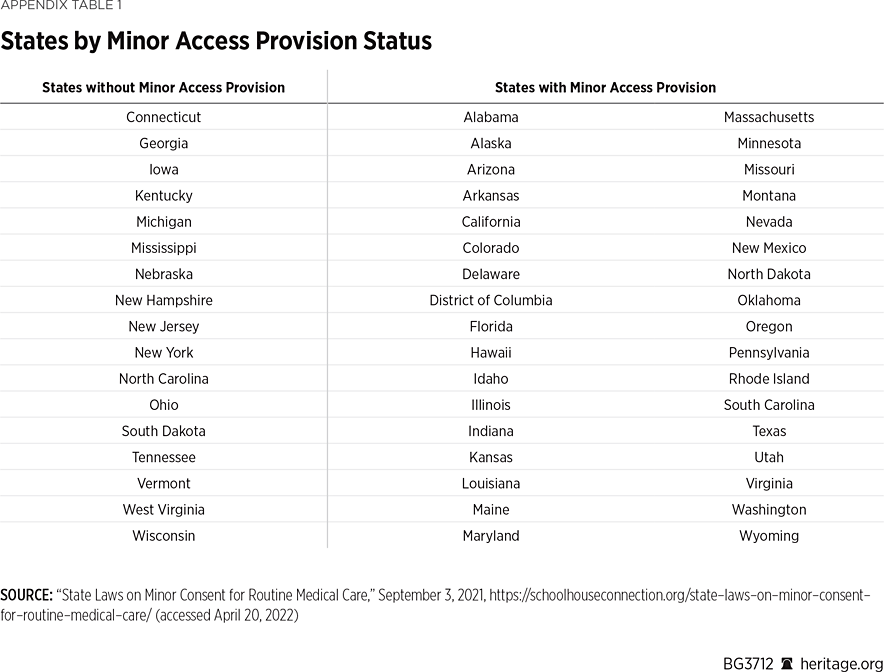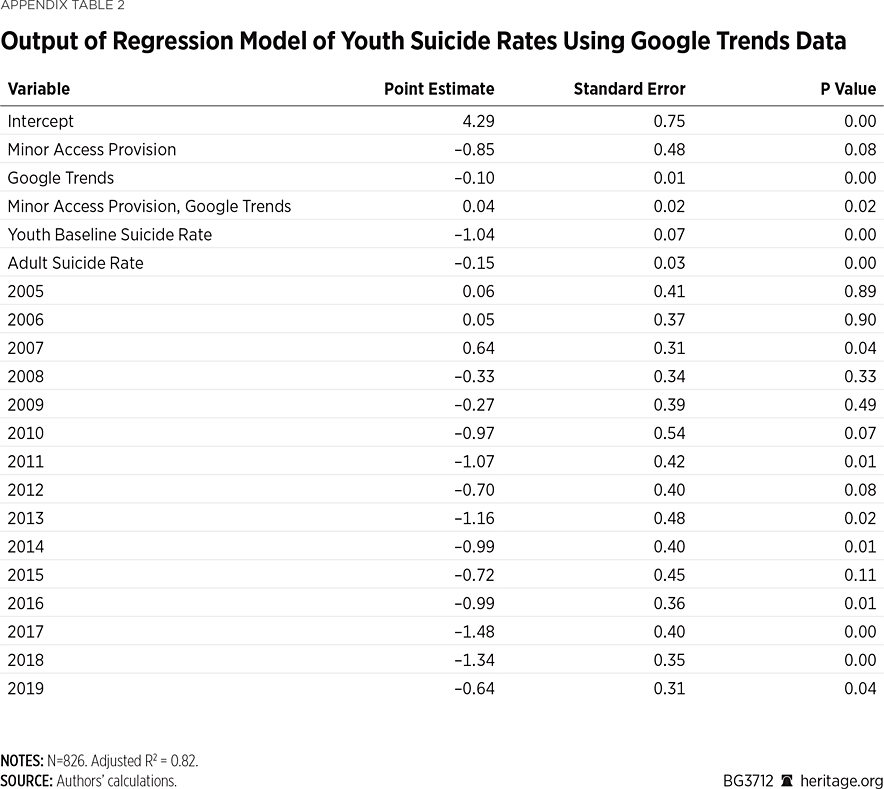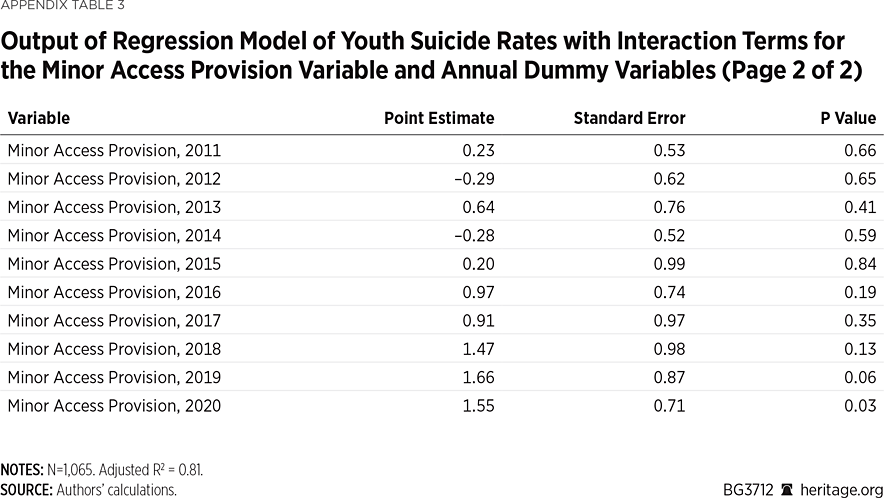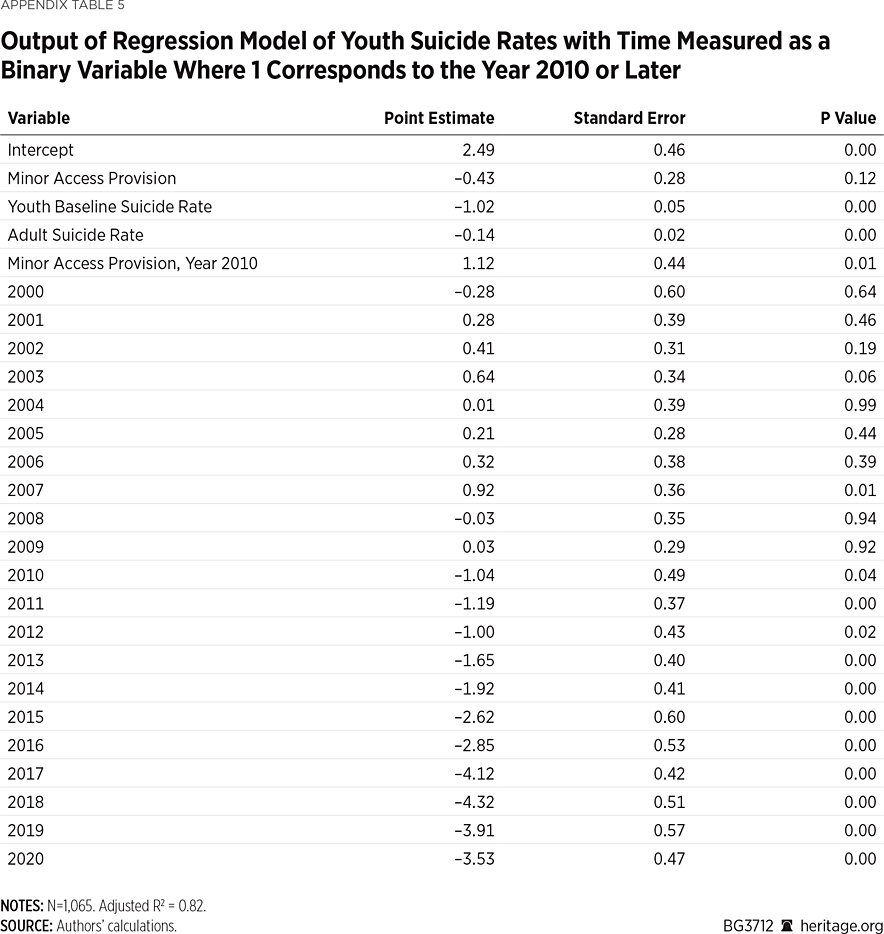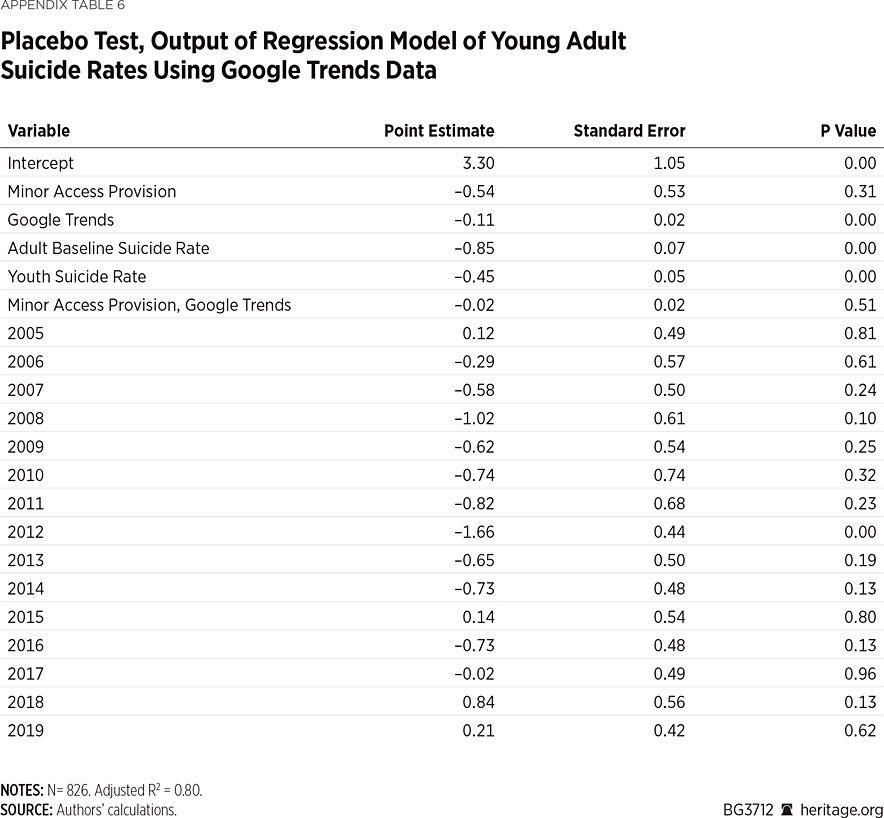Adolescents who are confused about their gender suffer from an abnormally high suicide rate.REF Though research demonstrates that gender confusion generally resolves itself without medical intervention,REF some educators and medical professionals encourage teens, and even pre-teens, to take puberty blockers or cross-sex hormones so that their secondary sex characteristics, such as body and facial hair, breast tissue, muscular build, and fat composition, align more closely with the gender with which they identify.REF While the World Professional Association for Transgender Health (WPATH) acknowledges that these interventions can have significant complications, it warns that delaying intervention also has serious risks:
Refusing timely medical interventions for adolescents might prolong gender dysphoria and contribute to an appearance that could provoke abuse and stigmatization. As the level of gender-related abuse is strongly associated with the degree of psychiatric distress during adolescence (Nuttbrock et al., 2010), withholding puberty suppression and subsequent feminizing or masculinizing hormone therapy is not a neutral option for adolescents.REF
Other advocates, members of the media, and even White House staff invoke scientific authority to assert that cross-sex medical interventions reduce the risk of suicide. Sarah Harte, director for the Washington, DC, branch of an organization that provides medical intervention and support for youth called The Dorm, stated with confidence that “[l]aws and systems barring gender-affirming healthcare will contribute to higher rates of significant mental health problems, including deaths by suicide.”REF The CEO of The Trevor Project, Amit Paley, said, “It’s clear that gender-affirming care has the potential to reduce rates of depression and suicide attempts.”REF
In an opinion piece in The Washington Post, University of Virginia Law School professors Anne Coughlin and Naomi Cahn claimed that cross-sex medication “has been shown to reduce the risk of depression and suicide for transgender youth,” and that “banning it creates an excruciating conflict for parents, as the steps they take to preserve their children’s lives may lead the state to investigate and punish them.”REF Even former White House press secretary Jen Psaki referred to such medical interventions as “medically necessary, lifesaving healthcare for [kids].”REF
The danger of adolescents committing suicide if they do not receive these medical interventions is thought to be so urgent that the Biden Administration recently issued a statement “confirming the positive impact of gender affirming care on youth mental health,” while referencing “the evidence behind the positive effects of gender affirming care.”REF A number of states have also considered or enacted legislation making it easier for minors to access cross-sex interventions without their parents’ knowledge or consent. For example, California recently enacted a new law, AB 1184, to prevent insurance companies from notifying parents if children on their policies receive “sensitive services,” which were defined to include “gender affirming care.”REF
However, young people may also experience significant and irreversible harms from such medical interventions.REF This Backgrounder reviews existing research on the relationship between cross-sex interventions and suicide, and then presents a new empirical analysis that examines whether easing access by adolescents to these interventions is likely to result in fewer adolescent suicides. The new analysis presented here finds that the existing literature on this topic suffers from a series of weaknesses that prevent researchers from being able to draw credible causal conclusions about a relationship between medical interventions and suicide. Using a superior research design, the new analysis finds that increasing minors’ access to cross-sex interventions is associated with a significant increase in the adolescent suicide rate. Rather than facilitating access by minors to these medical interventions without parental consent, states should be pursuing policies that strengthen parental involvement in these important decisions with life-long implications for their children.
The Context
Around 1990, some doctors in the Netherlands began to use drugs designed to delay the onset of puberty in teenagers who were confused about their gender.REF Puberty-blocking therapies, such as gonadotropin-releasing hormone analogues, were meant to prevent children entering puberty from developing the secondary sex characteristics, such as facial hair for men or breasts for women, if those features did not align with the gender with which they identified. Puberty blockers would be followed by the use of sex hormones, such as testosterone, for girls who identify as male, and estrogen for boys who identify as female, so that they could develop secondary sex characteristics that were associated with the sex that they identified with.REF
This treatment protocol of puberty blockers followed by cross-sex hormones among adolescents did not exist in the United States prior to 2007 and was extremely rare before 2010. Cross-sex hormones were available as a medical intervention for adolescents before 2010, but their use was extremely limited. Starting in 2010, however, the use of both puberty blockers and cross-sex hormones for adolescents who identified as transgender rose dramatically and was widely available by 2015.
Precise data are not available on how often puberty blockers and cross-sex hormones have been given to teenagers over time in the United States, but it is possible to track a proxy for these interventions. Google Trends provides data on the relative frequency that terms have been used for searches since 2004. A score of 100 in Google Trends indicates the peak frequency for the term. Before August 2007, Google Trends reports a 0 for the term “puberty blockers,” meaning that it was searched so infrequently in the U.S. that “there was not enough data for this term.” The term “puberty blockers” did not average 5, or one-twentieth of its peak popularity, in any year before 2015.REF
The average of the Google Trends scores for the terms, “puberty blockers,” “transgender,” “gender identity disorder,” and “gender dysphoria,” yields a reasonable proxy for how common cross-sex interventions have been over time.REF As shown in Chart 1, these four terms were searched infrequently until about 2015, when there was a dramatic increase that continued through the end of 2020. This picture is consistent with anecdotal reports of how the use of puberty blockers and cross-sex hormones only became widely available in the past several years.
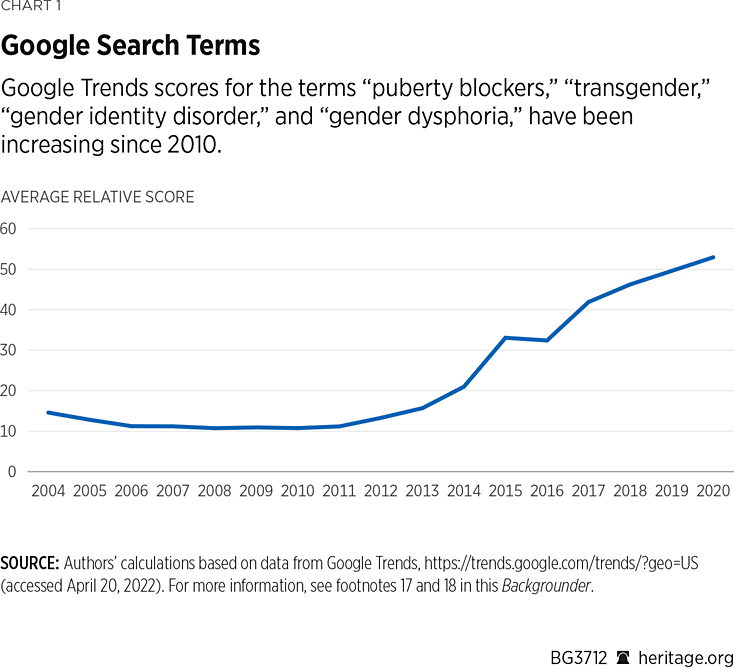
There is also a lack of precise information on where cross-sex medical interventions are more readily available to adolescents. A reasonable proxy for that data is to identify the states that have a legal provision allowing minors to access routine health care without the consent of their parents or guardian, at least under some circumstances. In states that have those provisions, puberty blockers and cross-sex hormones should be more easily available to teenagers.
The organization SchoolHouse Connection tracks state laws covering the ability of minors to access medical care without their parents’ consent as part of its advocacy on behalf of homeless children.REF SchoolHouse Connection documents that 33 states and the District of Columbia have some legal provisions that allow minors to obtain routine health care without parental consent.REF Seventeen states have no such provisions.
In states that do have such legal provisions, it is possible for adolescents to obtain puberty blockers and cross-sex hormones, at least under some circumstances, as those medical interventions have come into broader use for youth who identify as transgender.REF In states without such legal provisions, there is no regular process that allows adolescents to obtain puberty blockers or cross-sex hormones without their parents’ consent.
The conditions under which minors can access routine health care without parental consent are extremely limited in some states. For example, in Arizona a minor must be legally married, or documented as homeless, in order to access routine health care without parental consent.REF In other states, such as Minnesota, minors can obtain routine health care without parental consent if they live separately from their parents, regardless of the duration of that separation, and manage their own finances, regardless of their source of income.REF In other states, such as Alabama, Louisiana, and Oregon, there only appears to be a minimum age or a required determination by the health care provider that the minor is mentally competent to obtain health care without parental consent.REF
There is no obvious geographic, demographic, or partisan pattern to whether states have these provisions. As seen in Appendix Table 1, states without a provision are Connecticut, Georgia, Iowa, Kentucky, Michigan, Mississippi, Nebraska, New Hampshire, New Jersey, New York, North Carolina, Ohio, South Dakota, Tennessee, Vermont, West Virginia, and Wisconsin. The states with a provision are similarly diverse and settled on their legal arrangements long ago for reasons unrelated to the transgender issue.REF
Prior Research
The effects of puberty blockers and cross-sex hormones as a medical intervention for adolescents who identify as transgender have never been subjected to a large-scale randomized controlled trial (RCT), like the kind that is typically required for approval of new medications.REF Puberty blockers and sex hormones had been developed originally for other purposes. Puberty blockers were originally designed to delay precocious puberty among very young children who began puberty well before their peers. Sex hormones were developed primarily to treat people who were unable to produce enough of the hormones of their biological sex. These were the uses for which these drugs were originally tested and approved. These drugs have been prescribed for young people wishing to change their secondary sex characteristics without undergoing testing and formal approval for these new uses. The lack of any experimental evidence of the effects of these medical interventions prevents the gold-standard research one would normally expect in order to isolate the causal effects of these interventions.REF
The use of puberty blockers and sex hormones to address gender issues is also relatively recent, with widespread adoption occurring only within the past few years.REF The fact that randomized experiments were not required for this use of puberty blockers and sex hormones, and that this novel use of these drugs is relatively recent, means that only a handful of studies examine their effects, and all these studies use inferior correlational research designs.
The main defect of studies relying on correlational research designs is that they are unable to determine with confidence whether any relationships between receiving these drugs and later health outcomes are causal. That is, one can never know with confidence whether the drugs cause those outcomes, or whether other factors that make people more likely to receive the drugs were the causes. This inherent weakness in correlational research is precisely why regulators, such as the U.S. Food and Drug Administration, typically require randomized experiments before approving a drug.REF In an experiment, the only thing that determines whether people receive the medical intervention is chance, so any differences in outcomes between those who did and did not get the treatment would have to be caused by the intervention and not another factor.
This weakness of correlational research designs can be illustrated by examining one of the most prominent studies claiming to find that adolescents who receive cross-sex hormones have a lower risk of suicide.REF That study, led by Jack Turban of Stanford Medical School and published in PLOS ONE in 2022, examines the results of a 2015 survey of more than 27,000 American adults who identify as transgender. The survey was not meant to be representative of all such adults because its participants were recruited as a convenience sample, largely through transgender support groups. Subjects were asked whether they had ever sought cross-sex hormones, and then whether they had ever received them. Respondents who never sought cross-sex hormones were excluded from the analysis. The main comparison examined in the study was between those who had sought and received the hormones, and those who had sought but never received them when they were between 14 and 17.
The obvious defect in this comparison is that there are reasons why some people were able to get the hormones while others could not, even though all of them report wanting to get them. The reasons that allowed some to access them but not others are likely strongly related to later mental health. One of the most important reasons why some adolescents were able to access the hormone therapies while others could not is that parental consent is often, though not always, required to get these drugs. As is well known from research on gender-confused youth, as well as more generally, closer and more positive relationships between children and parents promote mental well-being and is protective against suicide.
The problem, then, with the Turban study, is that it is impossible to know whether the reduced odds of contemplating suicide among adults who sought and received hormone therapy as children were a result of the relationship with their parents who gave consent for this intervention or a result of the intervention itself. If a close and positive relationship between parents and children struggling with gender identity is the key to successful outcomes for those adolescents, then the hormones themselves might make no difference, or even be harmful. But that effect would be masked by the kind of parent–child relationship that exists when parents are more likely to consent.
Turban’s own data show enormous differences in relationships between children and parents among those who obtained the hormones and those who did not, despite desiring them. Of those who were unable to get the hormones, 35 percent had not “come out” to their parents, compared to 3 percent among those who obtained hormones at ages 14 and 15, and 4 percent among those who obtained hormones at ages 16 and 17. Among those who got the hormones as teenagers, nearly 80 percent reported feeling supported by their parents, compared to 33 percent of those who were unable to get the drugs.
Turban attempts to control statistically for these reported differences, but that adjustment cannot fully fix the bias, especially when the differences between the groups being compared are so stark and when the measures of parent–child relationship are imprecise. This would be like trying to adjust for the effects of family income during childhood knowing only whether someone reports having felt poor. Memories are imperfect, and simply dividing people into poor and not-poor categories fails to capture the difference between the children of billionaires and those raised in public housing projects. Adolescents who can get their parents’ consent for hormone therapy have dramatically different relationships with their parents than those who cannot, and that difference in relationship can affect mental health later in life, even if the hormones themselves have no benefit, or are harmful.
Another important factor that determines whether young people get cross-sex hormones is their psychological condition when they are seeking that intervention. According to guidelines issued by WPATH, a key condition for prescribing cross-sex hormones is that “any coexisting psychological, medical, or social problems that could interfere with treatment (e.g., that may compromise treatment adherence) have been addressed, such that the adolescent’s situation and functioning are stable enough to start treatment.”REF The difference between those who desired hormone therapy and received it and those who sought it but were unable to receive it could be the state of their mental health at the time they tried to get the drugs.
The Turban study lacks information on, and therefore cannot make any statistical adjustments for, the mental health at the time the subjects sought hormone therapy. The respondents who were unable to get hormone therapy despite saying they wanted it may have worse mental health outcomes because they began with more severe psychological issues that prevented them from obtaining the hormones. The pre-existing mental health challenges could be the cause of later outcomes, not whether they received the hormones.
The inability to sort out this kind of uncertainty about what is causing differences in mental health outcomes is inherent in the correlational research design employed by Turban and his colleagues. These same concerns apply to an earlier study by Turban and his colleagues published in Pediatrics in 2020. This study examines the relationship between puberty blockers and later mental health outcomes and relies on the same correlational research design to analyze data from the same survey as the cross-sex hormone study.REF The use of a correlational research design also makes it impossible to draw causal conclusions from a study by Amy Green and colleagues that analyzes the mental health effects of adolescents receiving cross-sex hormones based on data from a different survey.REF
The two studies led by Turban, and the one led by Green, are the only three studies that examine the relationship between cross-sex medical interventions by teenagers and suicide risks that make any use of a comparison group. As the 2020 Turban study describes itself, “This is the first study in which associations between access to pubertal suppression and suicidality are examined.”REF The 2022 Turban study observes that there have been six studies that track the mental health outcomes of teens who received hormone treatments, but emphasizes that “these studies did not include a comparison group of adolescents who did not access GAH [gender affirming hormones].”REF Studies that track adolescents who receive these medical interventions are even weaker than correlational studies in their ability to draw causal conclusions about the effects of those interventions, because they have no information on how those individuals would have fared had they not received the interventions.
The prior research on this subject is not only weak because it contains no credibly causal studies and only a handful of correlational studies, but also because those correlational studies are poorly executed. For example, the 2022 Turban study combines the use of testosterone for natal females and estrogen for natal males and only reports the combined effects of hormones. When Michael Biggs analyzes the same data and disaggregates the hormone by type, he finds that: “Males who took estrogen are more likely to plan suicide, to attempt suicide, and to require hospitalization for a suicide attempt.”REF This negative effect is masked in Turban’s study by the failure to report the separate effects by type of hormone.
Similarly, the 2022 Turban study finds that 16- and 17-year-olds who received hormones were more than twice as likely to report a “past-year suicide attempt requiring inpatient hospitalization,” but that finding fails to achieve statistical significance by setting the standard for significance higher than is conventional.REF Only by adopting a standard for statistical significance that is different from the one more commonly used in empirical research does the study avoid concluding that this significant harm from hormone therapy exists.
The two Turban studies do not consistently use the same set of control variables when generating their adjusted-odds ratio, even changing what is controlled when analyzing different outcomes within the same study. The two Turban studies also change the main outcome of interest from lifetime suicidal ideation in the study on puberty blockers to suicidal ideation in the last 12 months in the study on hormones. Researchers should determine which confounding variables to control and which outcome variable to examine in their statistical models based on sound theory and prior empirical research, and then consistently apply those decisions, especially within the same study. Changing which factors are controlled in the statistical analysis of each outcome variable, as well as which outcome on which to focus, opens the door to p-hacking, the process of changing empirical models in an ad hoc fashion to yield desired, though likely spurious, results.
The bottom line is that the most influential recent research on the relationship between adolescent cross-sex interventions and later mental health outcomes, including suicide risk, does not provide convincing evidence. Only a small number of studies make comparisons to a control group—and those studies employ correlational research designs that do not allow causal conclusions, nor have those correlational studies been conducted properly.
A Better Research Approach
Of all the adolescents who seek medical interventions for gender issues, there are reasons why some receive interventions while others do not. The defect of correlational research designs is that they cannot separate the effects of those reasons from the effects of the interventions themselves. A better research design would be built around the reasons why some do and others do not get the intervention, which have nothing to do with possible later outcomes. The gold standard of research designs is the RCT because then only chance determines whether some people get the treatment, not a factor that could be related to later outcomes.
Short of using lotteries to determine who gets the intervention, there are quasi-experiments or natural policy experiments,REF whereby the reason people, whether adults or minors, can or cannot get the intervention is determined primarily by policies that were adopted for reasons that have nothing to do with the later outcomes of treated individuals. This circumstance approximates a randomized experiment. By chance, some find themselves living under rules that allow them to access treatment, while others find themselves under different rules that do not allow them to do so.
There exists a natural policy experiment of this type with respect to the ability of minors to access gender-related medical interventions without their parents’ consent. As described above, some states have policies that provide a path by which minors can access routine medical care without the consent of a parent, while other states do not. These policies were developed for reasons that have nothing to do with gender identity. Whether adolescents live in a state that imposes fewer or no restrictions on accessing puberty blockers and cross-sex hormones is effectively random and should have nothing to do with later outcomes other than through the mechanism of receiving those interventions or not.
The analysis presented in this Backgrounder exploits this natural policy experiment to compare suicide rates over time among those ages 12 to 23 in states that have a provision allowing minors to access health care without parental consent relative to states that have no such provision. Annual suicide rates by age and state between 1999 and 2020 were obtained from the National Center for Injury Prevention and Control at the Centers for Disease Control and Prevention.REF Information on whether states had policies allowing minors to access routine health care without parental consent was obtained from SchoolHouse Connection, an organization focused on caring for homeless youth.REF
The analysis presented here uses a statistical model to predict the suicide rate among those ages 12 to 23 in each state between 1999 and 2020. The analysis focuses on this age range because it encompasses a consistent age group of those who could have entered puberty between 2010 and 2020 when puberty blockers and cross-sex hormones became available as a gender-related treatment in the United States. To control for the possibility that there are enduring cultural, religious, or other state-specific features that account for why some states have higher suicide rates among young people than other states, the model controls for average suicide rates in this age group in each state at baseline (during the first three years observed).
To control for the possibility that there are state-specific factors that account for why some states may generally experience changes in annual suicide rates, the model also controls for the suicide rate in each state in each year among those ages 28 to 39. The Heritage model controls for the suicide rate among that age group because it is a consistent age group in which no one would have been a minor in 2010 when puberty blockers and cross-sex hormones became available in the U.S. Because even the 28-year-olds in 2020 would have been 18 in 2010, none of them would be affected by variation in state policies regulating the ability of minors to receive health care without parental consent when these medical interventions began to be used.
The model also includes an indicator variable for each year between 1999 and 2020 to control for any year-specific national changes in suicide rates. And, because there may be correlations between the suicide rates within each state across the years examined, the model clusters the standard error estimates by state.
The independent variable of interest is a dichotomous measure of whether the state has a policy that allows minors to access health care without parental consent. If making it easier for minors to access puberty blockers and cross-sex hormones is protective against suicide, one should expect the frequency of youth suicide to be lower in states that have a provision allowing minors to get these drugs without parental consent after 2010. There should be no difference in trends in the suicide rate among young people based on whether states have a provision allowing minors to access health care without parental consent before 2010. If Turban and his colleagues are correct, the trends between these two groups of states should diverge after 2010 as cross-sex interventions became more widely available.
The trends are modeled statistically in a few ways. The most precise approach is to examine whether the suicide rate among young people is elevated as those interventions become more widely available in the states where it is easier for minors to access them. The model uses the prevalence of gender-related medical terms in Google Trends as a proxy for how widely available those interventions are over time.
Another approach would be to model the increased suicide rate in states where minors can access health care without parental consent over time. This could be done by including in the model an “interaction” variable that estimates the effect of whether states have a provision for minors accessing health care without parental consent each year separately. This variable would estimate the difference in youth suicide rates between states based on whether they have such a policy for each year between 1999 and 2020.
Yet another way to model the trend over time would be to estimate the combined effect of whether states have a policy along with a time variable that counts the number of years since 1999. This approach would identify any extant linear trend across time that differs between the two groups of states. It would also be possible to determine whether the two groups of states differ in their level or trend in youth suicide rates before and after 2010, when puberty blockers and cross-sex hormones become available.
The results remain substantively the same in their general magnitude, direction, and statistical significance regardless of the approach.
The Results
In the past several years, the suicide rate among those ages 12 to 23 has become significantly higher in states that have a provision that allows minors to receive routine health care without parental consent than in states without such a provision. Before 2010, these two groups of states did not differ in their youth suicide rates. Starting in 2010, when puberty blockers and cross-sex hormones became widely available, elevated suicide rates in states where minors can more easily access those medical interventions became observable.
Rather than being protective against suicide, this pattern indicates that easier access by minors to cross-sex medical interventions without parental consent is associated with higher risk of suicide. The Heritage model plotted the difference in a three-year rolling average of suicide rates between states with minor access provisions and states with no such provision. Chart 2 plots the trend in this difference for those ages 12 to 23 who could have been affected by the policy when cross-sex medical interventions became available. For comparison, Chart 2 also shows the trend in this difference for a group ages 28 to 39, who could not have been affected by these policies, since the people in this group would have been at least 18 when puberty blockers and cross-sex hormones became available.
Without making any adjustments, suicide rates among those ages 12 to 23 (blue line) begin to spike in states that have provisions that allow minors to access health care without parental consent relative to states that have no such provision around 2016, after cross-sex medical interventions became more common. By 2020, there are about 3.5 more suicides per 100,000 people ages 12 to 23 in states with easier access than in states without an access provision. There is no similar spike in suicide rates among those ages 28 to 39 (grey line) at that time.
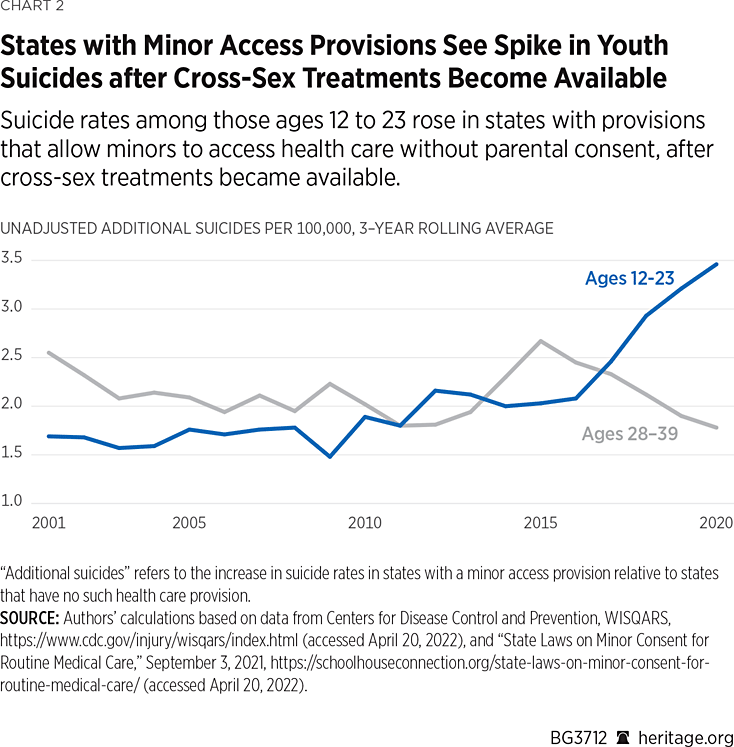
It is also clear that the states with a provision always had somewhat higher suicide rates than the states with no provision. To isolate the effect of this provision on youth suicide rates, it is better to control statistically for the youth suicide rate in each state at baseline as well as the suicide rate in each state in each year among the older and unaffected age group.
Making these adjustments and plotting three-year rolling averages yields the trend pictured in Chart 3. It is clear that the presence of a state-level provision for minors to access health care without parental consent makes no difference in suicide rates among those ages 12 to 23 until about 2010, when the suicide rate begins to drift up in states with easier access. In 2015, the estimated increase in suicide rates in states with easier access accelerates. By 2020, there are about 1.6 more suicides per 100,000 people ages 12 to 23 in states that have a policy allowing minors to access health care without parental consent than in states without such a policy. The average state suicide rate in this age group between 1999 and 2020 was 11.1, making an additional 1.6 suicides per 100,000 an increase of 14 percent in the suicide rate.
This increase in suicide rates in states where it is easier for minors to access puberty blockers and cross-sex hormones increased at almost the same time, and to the same degree, as those interventions became available. Using Google Trends results for the terms associated with those medical interventions as a proxy for their availability shows that increased suicide rates in states with easier access almost perfectly track the prevalence of those terms. (Compare Charts 1 and 3.)

This elevated rate of youth suicide is statistically significant at conventional levels, and robust to different approaches to modeling the trend over time. (See Appendix Tables 2–5 for regression results.)
It is useful to conduct a “placebo test” to examine whether the elevated rate of suicides among young people in states where it was easier for minors to access cross-sex interventions also existed among slightly older people who could not have been affected by minor access provisions. Using the same exact regression model while replacing the suicide rate among those ages 12 to 23 with the rate for those ages 28 to 39 in the same states as the dependent variable shows no relationship between the ease of accessing cross-sex medical care and suicide rates among those too old to have been affected by these state policies. (See Appendix Table 6.) This placebo test strongly indicates that making it easier for minors to access puberty blockers and cross-sex hormones when those interventions became available is causally related to increased suicide rates, because no similar increase was seen by those slightly older who would have been unaffected.
Discussion
The results presented in this Backgrounder provide strong evidence for the claim that suicides among young people have increased significantly since 2010 in states that have a policy allowing minors to access routine health care without parental consent. That increase in suicide rates accelerated around 2015. Prior to 2010, whether a state had such a policy or not had no significant effect on the trend in suicide rates among those ages 12 to 23. The timing of the increase in suicide rates only among young people, only after puberty blockers and cross-sex hormones are introduced and used widely, and only in states where minors could access those medical interventions without parental consent raises serious concerns about their effects on suicide risks.
The research presented here does not directly examine whether the individuals who receive gender-related medical interventions are at a higher risk of suicide, but it does directly examine the state policies that facilitate minors accessing those interventions without parental consent and finds that those policies raise suicide risks among young people.
To believe that easier access to puberty blockers and cross-sex hormones are not the cause of elevated suicide risk in those states, one would have to be able to imagine other medical interventions that only became widely available after 2010 and would only affect young people. The lack of theoretically plausible alternatives strengthens the case for concluding that cross-sex medical interventions are the cause of the observed increase in suicide among young people.
State Policy Recommendations
At a minimum, the results presented in this Backgrounder demonstrate that efforts to lower legal barriers for minors to receive cross-sex medical interventions do not reduce suicide rates and likely lead to higher rates among young people in states that adopt those changes. States that currently facilitate minors’ access to routine health care without the consent of a parent or legal guardian should consider revising such policies. States should also adopt parental bills of rights that affirm that parents have primary responsibility for their children’s education and health, and that require schools to receive permission from parents before administering health services to students, including medication and gender-related counseling to students under age 18.
This research adds to the well-established wisdom that children are better off if they are not allowed to make major life decisions without their parents’ involvement and permission. In general, parents are better positioned than anyone else, including the children themselves, to understand the needs of their children when making important decisions. State policies that undermine this relationship between parents and children are dangerous and should be repealed. Similarly, those who work with children in professional capacities, including health, education, and counseling, should be careful about substituting their own judgment for that of the parents. The research presented here supports the view that children fare significantly better when their parents have the authority to know about, and help to make, major decisions for their own children.
Lastly, given the danger of cross-sex treatments demonstrated in this Backgrounder, states should tighten the criteria for receiving these interventions, including raising the minimum eligibility age.
Jay P. Greene, PhD, is Senior Research Fellow in the Center for Education Policy at The Heritage Foundation. He thanks Jared Eckert, Research Assistant in Heritage’s Helen Devos Center for Life, Religion, and Family, and John Schoof, formerly of the Center for Education Policy, for their valuable research assistance.
